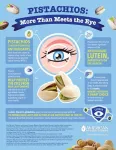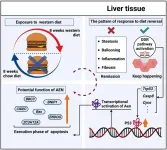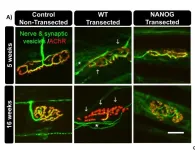(Press-News.org) BOSTON (Oct. 24, 2024) – People have heard for years that climate change is having a significant impact on plant vegetation patterns and influencing how pollen and mold produce. A new study being presented at this year’s American College of Allergy, Asthma and Immunology (ACAAI) Annual Scientific Meeting in Boston showed that, in Chicago, there has been a significant increase in sensitization to pollens and molds in patients with nasal allergies.
“Our goal was to analyze changes in pollen sensitization patterns over the past 10 years in Chicago to better understand the impact of climate change on airborne substances that can cause an allergic reaction,” says allergy fellow Kylie Jungles, MD, lead author of the study and ACAAI member. “Airborne allergens include any substance that can cause an allergic reaction, such as pollen, mold or dust mites. We wanted to see if climate change showed an association with those substances in terms of increasing the rates of sensitization.”
Allergic sensitization is the process by which the body develops antibodies to allergens, which are components of substances normally occurring in the environment, that are inhaled, ingested, or absorbed. It is the first step in a person becoming allergic to a substance.
In the study, a retrospective chart review was conducted on patients with nasal allergies seen at an allergy center in Chicago from 2014-2024. Data from blood tests was collected, as well as patient specific characteristics including age, gender, and other allergic conditions.
Allergen testing from 1,052 patients was analyzed from 2014-2019 (pre-COVID) and 2022-2024 (post-COVID.) The rate of sensitization to outdoor aeroallergens significantly increased in the post-COVID period compared to pre-COVID. Tree pollen (69.8% vs. 49.3%), weed pollen (76.1% vs. 54.1%), grass pollen (100% vs. 57.7%), and mold (76.7% vs. 46.5%) all increased post-COVID compared to pre-COVID. Despite the increased sensitization to outdoor allergens during these time periods, sensitizations to indoor allergens (cat and dog) were not significantly different.
The authors conclude, “This increased sensitivity may be due to changing patterns of pollen and mold proliferation secondary to increased temperatures, rainfall, and rising water levels that Chicago has been experiencing due to climate change. More research is needed to investigate the impact of climate change on aeroallergen sensitization.”
Abstract Title: CHANGE OF SENSITIZATION PATTERNS TO POLLENS OVER THE PAST DECADE
(Full abstract below)
Presenter: Kylie Jungles, MD
For more information about food allergies, or to find an allergist in your area, visit AllergyandAsthmaRelief.org. The ACAAI Annual Scientific Meeting is Nov. 9-13. For more news and research from the ACAAI Scientific Meeting, go to our newsroom and follow the conversation on X/Twitter #ACAAI24.
About ACAAI
The American College of Allergy, Asthma & Immunology (ACAAI) is a professional medical organization of more than 6,000 allergists-immunologists and allied health professionals, headquartered in Arlington Heights, Ill. Founded in 1942, the College fosters a culture of collaboration and congeniality in which its members work together and with others toward the common goals of patient care, education, advocacy, and research. ACAAI allergists are board-certified physicians trained to diagnose allergies and asthma, administer immunotherapy, and provide patients with the best treatment outcomes. For more information and to find relief, visit AllergyandAsthmaRelief.org. Join us on Facebook, Pinterest, Instagram and X/Twitter.
R337
CHANGE OF SENSITIZATION PATTERNS TO POLLENS OVER THE PAST DECADE
K. Jungles*1, K. Singh1, S. Armana1, C. Juarez1, S. Pacheco2, M. Mahdavinia2, 1. Chicago, IL; 2. Houston, TX.
Introduction: Climate change is a growing and urgent public health concern. In the field of Allergy and Immunology specifically, there is concern that climate change is impacting plant vegetation patterns, thereby influencing patterns of pollen and mold proliferation. We aimed to analyze changes in pollen sensitization patterns over the past ten years to further understand the impact of climate change on aeroallergen sensitization.
Methods: A retrospective chart review was conducted on patients with allergic rhinitis (AR) seen at a tertiary care center in Chicago from 2014-2024. InVitro aeroallergen data was collected, as well as patient specific characteristics including age, gender, and atopic comorbidities.
Results: InVitro aeroallergen testing from 1,052 patients was analyzed from 2014-2019 (pre-COVID) and 2022-2024 (post-COVID.) Interestingly, the rate of sensitization to outdoor aeroallergens significantly increased in the post-COVID timeframe compared to pre-COVID. Tree pollen (69.8% vs. 49.3%), weed pollen (76.1% vs. 54.1%), grass pollen (100% vs. 57.7%), and mold (76.7% vs. 46.5%) all increased post-COVID compared to pre-COVID. Despite the increased sensitization to outdoor allergens during these time periods, sensitizations to indoor allergens (cat and dog) were not significantly different.
Conclusion: There has been a significant increase in sensitization to pollens and molds in patients with AR living in Chicago over the past decade. This increased sensitivity may be due to changing patterns of pollen and mold proliferation secondary to increased temperatures, rainfall, and rising water levels that Chicago has been experiencing due to climate change. Additional research is needed to investigate the impact of climate change on aeroallergen sensitization.
END
Study shows rates of sensitization in Chicago to outdoor allergens increased post-COVID
Sensitizations to indoor allergens such as dog and cat did not change
2024-10-24
ELSE PRESS RELEASES FROM THIS DATE:
Phase Two results with CRISPR-Cas9 gene editing support further development as treatment for hereditary angioedema (HAE)
2024-10-24
A single treatment with, a CRISPR-Cas9 based gene editing therapy, is enough to replace the daily medication of patients with hereditary angioedema (HAE), a condition characterized by severe, painful and sudden onset of swelling, sometimes resulting in death. Confirming the findings published earlier this year from researchers from Amsterdam UMC, the University of Auckland and Cambridge University Hospitals NHS Foundation Trust. This phase two study is published today in the New England Journal of Medicine and presented at American College of Allergy, Asthma & Immunology's annual congress on the ...
Take aim at the pause!
2024-10-24
A collaborative research group, including researchers from Exploratory Research Center on Life and Living Systems and Institute for Molecular Science of National Institutes of Natural Sciences, as well as Nagoya City University, Nagoya University, and University of Tsukuba, has uncovered a new mechanism in the growth of amyloid β (Aβ) fibrils, which are closely associated with Alzheimer’s disease. Using advanced high-speed atomic force microscopy (HS-AFM), the team was able to observe Aβ fibril growth at the molecular ...
Pistachios may help improve eye health, new study finds
2024-10-24
A new study1 from researchers at the Friedman School of Nutrition Science and Policy at Tufts University has found that consuming pistachios daily may significantly improve eye health by increasing macular pigment optical density (MPOD), due to the plant pigment lutein, a key factor in protecting the eyes from blue (visible) light and age-related damage.
The randomized controlled trial showed that compared to eating a usual diet alone, eating 2 ounces (57 grams) of pistachios per day for 12 weeks as part of a usual diet resulted in a significant increase in MPOD in otherwise healthy middle-aged to older adults. MPOD is an important indicator of eye health, ...
Transcriptomic landscape analysis reveals a persistent DNA damage response in metabolic dysfunction-associated steatohepatitis post-dietary intervention
2024-10-24
Background and Aims
Metabolic dysfunction-associated steatotic liver disease (MASLD) and its more advanced form, metabolic dysfunction-associated steatohepatitis, have emerged as the most prevalent liver diseases worldwide. Currently, lifestyle modification is the foremost guideline-recommended management strategy for MASLD. However, it remains unclear which detrimental signals persist in MASLD even after disease remission. Thus, we aimed to examine the persistent changes in liver transcriptomic profiles following ...
ECOG-ACRIN and Caris Life Sciences partner to interrogate landmark TAILORx breast cancer trial
2024-10-24
ECOG-ACRIN Cancer Research Group (ECOG-ACRIN) and Caris Life Sciences®(Caris) announced today a multi-year research collaboration wherein Caris is pairing its highly sophisticated and comprehensive genomic, transcriptomic and proteomic profiling, advanced artificial intelligence (AI) and machine learning algorithms with ECOG-ACRIN’s immense research capabilities. The first project is underway and leverages the tumor tissue samples from the Trial Assigning Individualized Options for Treatment (Rx) or TAILORx, breast cancer clinical trial. TAILORx is one of the world's largest breast cancer research resources. The TAILORx trial and its associated biospecimen ...
Ion-pairing: A new approach to lyotropic chromonic liquid crystal assembly
2024-10-24
Self-assembling molecules into organized structures is highly valuable for developing new materials. One notable class of these materials is lyotropic chromonic liquid crystals (LCLCs), which are molecular assemblies of amphiphilic π-electronic molecules, with water-absorbing and water-repelling parts. The term “lyotropic” refers to liquid crystal phases that depend on the concentration of the molecules in a solvent, while “chromonic” indicates that these molecules are stacked into columnar assemblies. In a solvent, these structures are stabilized by π–π interactions and hydrophobic effects. Examples of ...
Popular diabetes and weight-loss drug may reduce risk of Alzheimer’s disease
2024-10-24
CLEVELAND—Researchers at the Case Western Reserve School of Medicine have found that, when compared to seven other anti-diabetic drugs, semaglutide, a popular diabetes and weight-loss drug, may lower the risk of Alzheimer’s disease in people with type 2 diabetes (T2D).
Alzheimer’s disease is a brain disorder that slowly destroys memory and thinking skills. According to the Alzheimer’s Association, nearly 7 million Americans 65 and older are living with the disease, and there are more deaths from Alzheimer’s than breast and prostate cancer combined.
The study, published ...
Feeding practices play a central role in infants’ rapid weight gain, UNC Greensboro researchers find
2024-10-24
A UNC Greensboro (UNCG) study following 299 women and their infants from pregnancy to toddlerhood examined mul ple psychological, biological, and social factors in the context of infants’ rapid weight gain. They found infant feeding practices associated with obesity, known as obesogenic practices, are strongly correlated with rapid infant weight gain.
Examples of obesogenic practices described in their recent Pediatric Obesity paper include watching television while feeding a baby, formula feeding, and supplementing a bottle with additional foods.
“The key take ...
New AI tool predicts protein-protein interaction mutations in hundreds of diseases
2024-10-24
Scientists from Cleveland Clinic and Cornell University have designed a publicly-available software and web database to break down barriers to identifying key protein-protein interactions to treat with medication.
The computational tool is called PIONEER (Protein-protein InteractiOn iNtErfacE pRediction). Researchers demonstrated PIONEER’s utility by identifying potential drug targets for dozens of cancers and other complex diseases in a recently published Nature Biotechnology article.
Genomic research is key in drug discovery, but it is not always enough on its own, says Feixiong Cheng, PhD, study co-lead author and director of Cleveland Clinic’s Genome Center. When ...
Gene named for mythical Irish land could aid muscle function after traumatic nerve injuries
2024-10-24
BUFFALO, N.Y. — The key to recovering from traumatic nerve injuries, like those sustained in motor vehicle accidents or gunshot wounds, may be a gene named for the land of everlasting youth in Irish folklore.
In a study published today (Oct. 24) in Nature Communications, a University at Buffalo-led research team describes how the gene, called NANOG, can improve the regrowth of damaged nerves and re-establish innervation (the process of nerves growing and connecting with organs or tissues) after traumatic severing of peripheral nerves.
The gene’s name is derived from Tír na nÓg, which is a mythical ...
LAST 30 PRESS RELEASES:
Scientists discover first method to safely back up quantum information
A role for orange pigments in birds and human redheads
Pathways to net-zero greenhouse gas emissions for Southeast Asia
A JBNU–KIMS collaborative study on a cost-effective alloy matches superalloys for power plants and energy infrastructure
New study overturns long-held model of how plants coordinate immune responses.
New AI model predicts disease risk while you sleep
Scientists discover molecular ‘reshuffle’ and crack an 80-year-old conundrum
How stressors during pregnancy impact the developing fetal brain
Electrons lag behind the nucleus
From fungi to brain cells: one scientist's winding path reveals how epigenomics shapes neural destiny
Schizophrenia and osteoporosis share 195 genetic loci, highlighting unexpected biological bridges between brain and bone
Schizophrenia-linked genetic variant renders key brain receptor completely unresponsive to both natural and therapeutic compounds
Innovative review reveals overlooked complexity in cellular energy sensor's dual roles in Alzheimer's disease
Autism research reframed: Why heterogeneity is the data, not the noise
Brazil's genetic treasure trove: supercentenarians reveal secrets of extreme human longevity
The (metabolic) cost of life
CFRI special issue call for papers: New Frontiers in Sustainable Finance
HKU Engineering scholar demonstrates the smallest all-printed infrared photodetectors to date
Precision empowerment for brain "eavesdropping": CAS team develops triple-electrode integrated functional electrode for simultaneous monitoring of neural signals and chemical transmitters during sleep
Single-capillary endothelial dysfunction resolved by optoacoustic mesoscopy
HKU three research projects named among ‘Top 10 Innovation & Technology News in Hong Kong 2025’ showcasing excellence in research and technology transfer
NLRSeek: A reannotation-based pipeline for mining missing NLR genes in sequenced genomes
A strand and whole genome duplication–aware collinear gene identification tool
Light storage in light cages: A revolutionary approach to on-chip quantum memories
Point spread function decoupling in computational fluorescence microscopy
BacPhase: Long-insert paired-end sequencing for bin marker construction and genome phasing
GmWOX1 regulates the mediolateral polarity of compound leaves in soybean
ChargeFabrica: An open-source simulation tool that aims to accelerate search for high performance perovskite solar cells
High levels of ADAR overexpression induce abundant and stochastic off-target RNA editing in rice protoplasts
On-demand upgraded recycling of polyethylene and construction of sustainable multifunctional materials based on the "LEGO" strategy
[Press-News.org] Study shows rates of sensitization in Chicago to outdoor allergens increased post-COVIDSensitizations to indoor allergens such as dog and cat did not change






